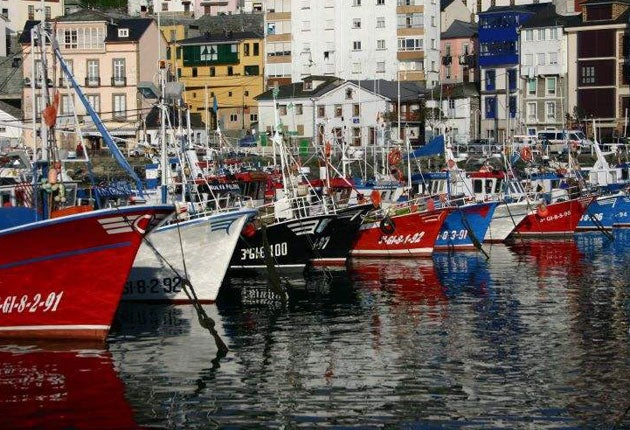This stretch of Spanish coast is a peaceful place – for now
New transport links are about to put Asturias on our radar, says Bill Tuckey

It looks like the perfect wave, and my daughter, gripping her bodyboard tightly, is determined to catch it. I'm by her side, waist deep in the foaming Atlantic, when I feel something drive into my heel. A stone? An urchin? At this point, it doesn't hurt much, so I give her a shove and she's soon flying towards the beach. And what a beach – a great, wild expanse of sand flanked by craggy cliffs, caves and crazy rock formations, and backed by the kind of primeval forest you'd expect a brontosaurus to come crashing out of at any minute.
A stream meanders across the eastern end, cutting a perfect tunnel through a large rock. My two boys have been running through it like trains all morning; the sun is shining and there's virtually no one else around.
Notwithstanding the fast-rising pain in my foot, it's about as good a family seaside spot as one could dream of, and one of many equally dramatic, empty beaches on this stretch of coast, just an overnight ferry ride and a three-hour drive from Britain. This is western Asturias: a mountainous region on Spain's northern, Atlantic coast which, thanks to its reputation for poor transport links and terrible weather, retains a sense of isolation.
It might not remain that way for long, though. There's now a daily easyJet flight from London to Oviedo and a new extension to the A8 coastal motorway, which runs from Bilbao.
But today there is a serpent in this paradise, or at least some kind of underwater beastie. Within five minutes, my foot is on fire, and it's only after a panicked hobble to the lifeguard shack here on Playa Otur that I'm reassured death is not imminent. The guard adds my name to his long casualty list, all victims of the stinging spines of the pez escorpion, whose name translates, rather disappointingly, as the weaver fish.
Two hours later, I have recovered the use of my left foot and we are driving back to our home for the week, Casa Vieja, a 300-year-old farmhouse whose lush garden contains orange trees and one of the region's distinctive, pagoda-like horreos (wooden grain stores on stone pillars). The house, rented from local specialists Casas Cantabricas, is filled with lovely antique furniture and perched above the slightly redneck-ish village of Trevias, five miles inland. From our verandah you can see chestnut, oak and beech forests, with birds of prey wheeling above the trees.
There are men with berets and women with pitchforks in the nearby fields, who peer at my family with curiosity and a touch of suspicion. The fact that we're in the Asturian county of Vaqueira might go some way to explain their reserve. Many of the locals are the descendants of nomadic cowherders, vaqueiros – an ethnic group who were historically discriminated against by their more sedentary neighbours. It also explains the omnipresent whiff of cowpat.
Asturias has always stood somewhat apart. This was the one area of Spain that was never taken by the Moors. Elegant, pre-Romanesque churches dot the landscape, and the domestic architecture is oddly alpine. The Asturian golden-cross flag adorns many a rear windscreen and its culture can be seen in the region's sidrerias, cider houses, and restaurants serving bean and pork casseroles, local cheeses and oceans of seafood.
You can watch them landing the catch in the sweet, sleepy, fishing village of Luarca, or at Cudillero, whose winding lanes and red-tiled houses are steeply raked around a ravishing harbour. It's the closest that this part of Asturias comes to a tourist trap; the real crowds are near the border with Cantabria.
Holidaymakers here are mostly Spaniards from the plains who don't mind a drop of rain. But while it's obvious from the verdant scenery that it chucks it down with Irish regularity, we experienced only one downpour in our entire week's stay, with temperatures in the mid-20s.
There's plenty to do if it's too wet to sunbathe. In the wild countryside, bears and wolves still roam, and one inland excursion took us to Tunon where you can hire bikes to follow the Senda del Oso, "the bear trail", along the tracks of a disused mining railway. From there we drove deeper still into the Cantabrian mountains to the Somiedo nature reserve, where the alpine scenery is more dizzying still.
With more time, we might have gone rafting or salmon fishing, but for my children, perhaps the most thrilling trip of all was the one home. Among the facilities on the overnight Brittany Ferry from Santander to Plymouth is a tiny swimming pool on the top deck – or, to be more accurate, a great sloshing bowl of overexcited child soup. And then, at dusk, we saw whales.
Compact facts
How to get there
The three-bedroom Casa Vieja costs from £560 for a week with Casas Cantabricas (01223 328721; www.casas.co.uk). Return crossings from Portsmouth or Plymouth to Santander start at £372 in high season for a car with up to five people with Brittany Ferries (0871 244 1400; brittanyferries.com). Accommodation on board from £7 per person each way.
Further informantion
Spanish Tourist Board (020-7486 8077; www.spain.info).
Join our commenting forum
Join thought-provoking conversations, follow other Independent readers and see their replies
Comments
Bookmark popover
Removed from bookmarks